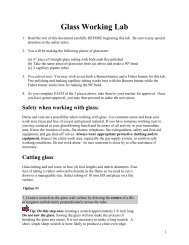Chapter 15: Solutions - Weironline.net
Chapter 15: Solutions - Weironline.net
Chapter 15: Solutions - Weironline.net
Create successful ePaper yourself
Turn your PDF publications into a flip-book with our unique Google optimized e-Paper software.
a b c<br />
Figure <strong>15</strong>-1<br />
a The air you breathe is a gas<br />
solution primarily containing<br />
oxygen, nitrogen, and argon.<br />
b The biological reactions necessary<br />
for life occur in aqueous<br />
solutions within cells. c A solid<br />
solution of titanium and nickel is<br />
commonly used for braces in<br />
orthodontia.<br />
454 <strong>Chapter</strong> <strong>15</strong> <strong>Solutions</strong><br />
Table <strong>15</strong>-1 lists examples of different types of solutions. Note that the<br />
solutes in the solutions may be gases, liquids, or solids. Which solutions contain<br />
gaseous solutes? Which solutions are aqueous? Note also that solutions<br />
such as ocean water can contain more than one solute.<br />
Some combinations of substances readily form solutions and others do not.<br />
A substance that dissolves in a solvent is said to be soluble in that solvent.<br />
For example, sugar is soluble in water, a fact you probably learned by dissolving<br />
sugar in flavored water to make a sweetened beverage such as tea,<br />
lemonade, or fruit punch. A substance that does not dissolve in a solvent is<br />
said to be insoluble in that solvent. Sand is insoluble in water. Have you ever<br />
shaken a bottle of oil and vinegar when making salad dressing? If so, what<br />
happens to the liquids shortly after you stop mixing them? You are correct<br />
if you answered that they separate, or cease to mix. Oil is insoluble in vinegar;<br />
and thus, oil and vinegar are said to be immiscible. Two liquids that are<br />
soluble in each other, such as those that form the antifreeze listed in<br />
Table <strong>15</strong>-1, are said to be miscible. Are water and acetic acid miscible?<br />
Table <strong>15</strong>-1<br />
Types and Examples of <strong>Solutions</strong><br />
Type of solution Example Solvent Solute<br />
Gas<br />
Gas in gas Air Nitrogen (gas) Oxygen (gas)<br />
Liquid<br />
Gas in liquid Carbonated water Water (liquid) Carbon dioxide (gas)<br />
Gas in liquid Ocean water Water (liquid) Oxygen gas (gas)<br />
Liquid in liquid Antifreeze Water (liquid) Ethylene glycol<br />
(liquid)<br />
Liquid in liquid Vinegar Water (liquid) Acetic acid (liquid)<br />
Solid in liquid Ocean water Water (liquid) Sodium chloride<br />
(solid)<br />
Solid<br />
Liquid in solid Dental amalgam Silver (solid) Mercury (liquid)<br />
Solid in solid Steel Iron (solid) Carbon (solid)




